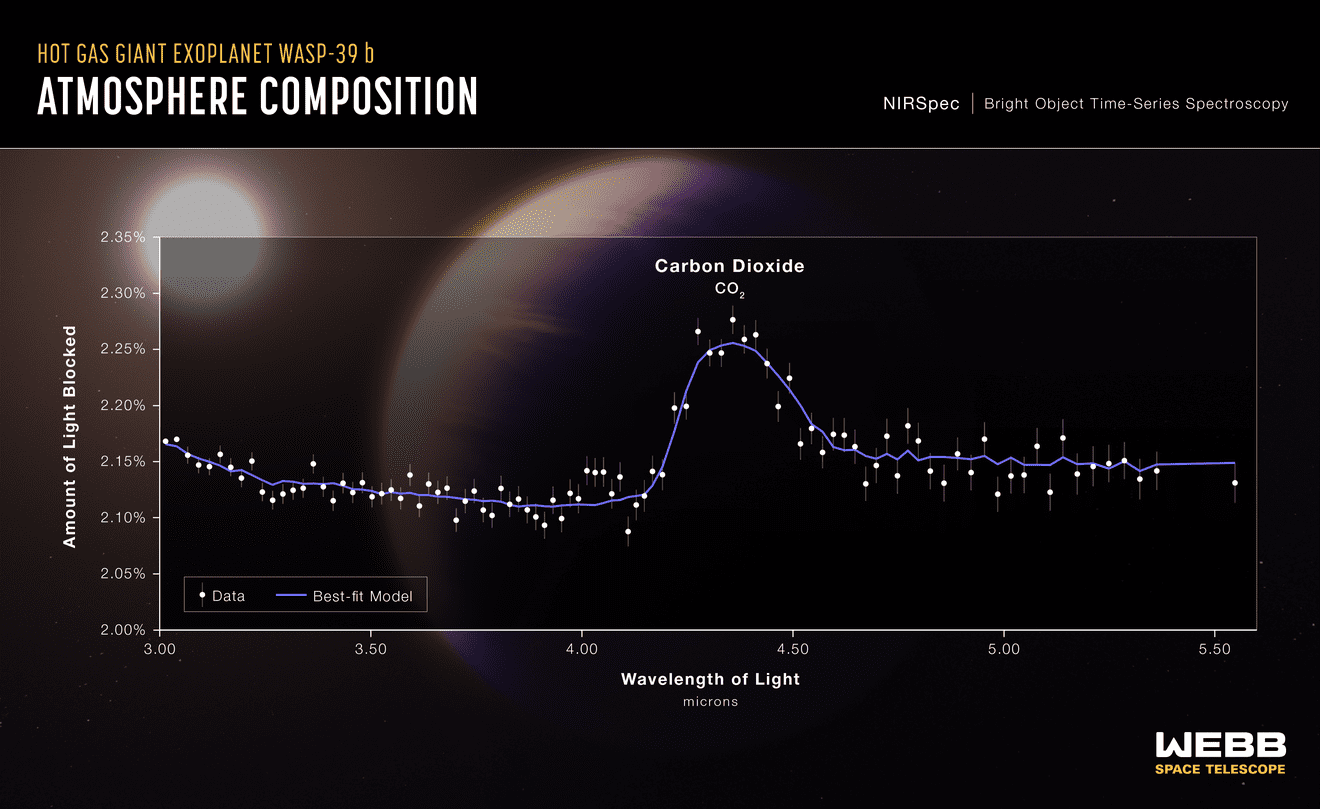JWST has been delivering incredible observations of faraway galaxies and nearby planets, but now it has delivered the incredible exoplanet science that many astronomers have been waiting for. The space telescope has detected the first “unequivocal” carbon dioxide in the atmosphere of a distant world, the first-ever undisputable detection like it.
Described in a paper accepted for publication in Nature and available on the preprint server ArXiv, the detection was in the atmosphere of exoplanet WASP-39 b, a well-known planet orbiting a Sun-like star 700 light-years away. The world passes in front of its star from our line of sight and in doing so it blocks part of the light, which is how we know it’s there.
JWST is designed to study the light and determine what in the atmosphere may have blocked particular infrared colors. WASP-96b was actually one of its first scientific targets, and it has already detected water vapor there. Now, it’s detected carbon dioxide (CO2) too.
“Previous observations of this planet with Hubble and Spitzer had given us tantalizing hints that carbon dioxide could be present,” Professor Natalie Batalha of UC Santa Cruz who led the team that made the detection, said. “The data from JWST showed an unequivocal carbon dioxide feature that was so prominent it was practically shouting at us.”

The signal that demonstrates the presence of CO2 on WASP-39 b. Image credit: Illustration: NASA, ESA, CSA, and L. Hustak (STScI); Science: The JWST Transiting Exoplanet Community Early Release Science Team
“As soon as the data appeared on my screen, the whopping carbon dioxide feature grabbed me,” Zafar Rustamkulov, a graduate researcher at Johns Hopkins University and member of the team, said. “It was a special moment, crossing an important threshold in exoplanet sciences.”
WASP-39 b is a hot gas giant, orbiting close to its star, which makes it balloon as a planet. So while it has the mass of Saturn, it’s much bigger, with a diameter 1.3 times larger than Jupiter. Its closeness to the star, roughly one-eighth of the distance between the Sun and Mercury, makes it extremely hot, about 900°C ( 1,300°F). There’s nothing like this world in our Solar System.
Stars and gas giants are mostly made up of light elements like hydrogen and helium, but heavier elements are critical for planet formation. CO2 is an important ingredient in the atmospheres of our Solar System’s planets, found in both the rocky planets like Mars and Venus and the gas giants Saturn and Jupiter. CO2 also makes a great indicator of the abundance of heavier elements in the gas giants’ atmosphere.
“The ability to determine the amount of heavy elements in a planet is critical to understanding how it formed, and we’ll be able to use this carbon dioxide measuring stick for a whole bunch of exoplanets to build up a comprehensive understanding of giant planet composition,” co-author Jonathan Fortney, professor at UC Santa Cruz and director of the Other Worlds Laboratory, said.
This is just the beginning of JWST’s exoplanets exploration, and not just of gas giants but Earth-like worlds, too.
“As we have discovered thousands of exoplanets over the past two and a half decades, we’ve realized that most other planetary systems are very different from our own,” team member Peter Gao from the Carnegie Institution for Science said.
“The leap that JWST is enabling in our ability to study exoplanet atmospheres will significantly advance our knowledge of how they are shaped by their host star’s composition and planetary system’s evolution, which may provide answers about why our Solar System is so different.”
Some of the worlds being studied by JWST still need a name, and you can be a part of space history and join the competition to name them right here.
Source Link: JWST Detects “Unequivocal” Carbon Dioxide In An Exoplanet’s Atmosphere For First Time